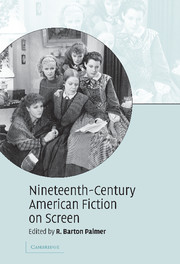Book contents
- Frontmatter
- Contents
- List of illustrations
- Notes on contributors
- Acknowledgments
- Introduction
- 1 A very American fable: the making of a Mohicans adaptation
- 2 Romancing the letter: screening a Hawthorne classic
- 3 The movies in the Rue Morgue: adapting Edgar Allan Poe for the screen
- 4 Readapting Uncle Tom's Cabin
- 5 Screening authorship: Little Women on screen 1933–1994
- 6 Melville's Moby-Dick and Hollywood
- 7 Screening male sentimental power in Ben-Hur
- 8 John Huston's The Red Badge of Courage
- 9 Translating Daisy Miller
- 10 Jane Campion's The Portrait of a Lady
- 11 The Europeans – and the Americans
- 12 Sister Carrie becomes Carrie
- 13 Hollywood and The Sea-Wolf
- 14 An untypical typicality: screening Owen Wister's The Virginian
- Filmography
- Index
11 - The Europeans – and the Americans
Published online by Cambridge University Press: 22 December 2009
- Frontmatter
- Contents
- List of illustrations
- Notes on contributors
- Acknowledgments
- Introduction
- 1 A very American fable: the making of a Mohicans adaptation
- 2 Romancing the letter: screening a Hawthorne classic
- 3 The movies in the Rue Morgue: adapting Edgar Allan Poe for the screen
- 4 Readapting Uncle Tom's Cabin
- 5 Screening authorship: Little Women on screen 1933–1994
- 6 Melville's Moby-Dick and Hollywood
- 7 Screening male sentimental power in Ben-Hur
- 8 John Huston's The Red Badge of Courage
- 9 Translating Daisy Miller
- 10 Jane Campion's The Portrait of a Lady
- 11 The Europeans – and the Americans
- 12 Sister Carrie becomes Carrie
- 13 Hollywood and The Sea-Wolf
- 14 An untypical typicality: screening Owen Wister's The Virginian
- Filmography
- Index
Summary
One of the crucial differences between the Merchant Ivory film version of The Europeans (1979, UK) and Henry James's novel is that the film omits the novel's striking opening chapter. In this chapter James establishes with wonderful exactness the differences between a brother and sister in their approaches to America. This brother and sister – Felix, who earns his living precariously “by going about the world and painting bad portraits” and Eugenia, the Baroness Munster of Silberstadt-Schreckenstein – are “the Europeans” of the title, though they are actually expatriate Americans returning home. The title is thus ironic: they are not so much Europeans as Europeanized and must learn again to be Americans if they are to find their niche in the closely organized world of New England.
This opening chapter establishes with wit and subtlety what this pair of siblings is up to. Eugenia is in retreat from an unsatisfactory marriage: she has been the morganatic wife of a minor German princeling, and she has come to America quite explicitly to seek her fortune. Felix has come seeking entertainment: if the Wentworths, the New England cousins they have come to visit, are rich, so much the better, but this is not a condition of his entertainment. To him, it will be merely “pleasanter” if they are rich (they are), whereas Eugenia can ask rhetorically, “Do you suppose if I had not known they were rich I would ever have come?” (13).
- Type
- Chapter
- Information
- Nineteenth-Century American Fiction on Screen , pp. 175 - 185Publisher: Cambridge University PressPrint publication year: 2007

